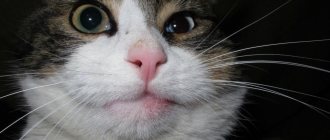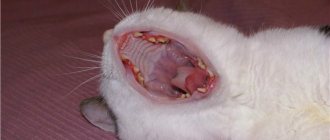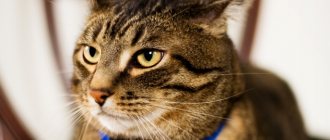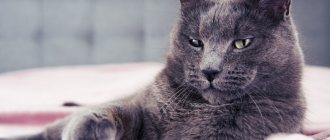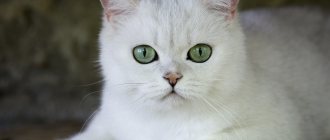Lentigo
The most common cause of black spots in a cat's mouth is increased pigment formation. Sometimes kittens are born with small spots, which become more noticeable as they grow older. These dark marks are called lentigines and their appearance is not dangerous for furry pets. However, stains with this defect should not:
- itch;
- protrude above the surface of the skin and mucous membranes;
- have a rough surface;
- peel off.
Most often, lentigo occurs in red or tortoiseshell cats.
Causes of moles
There is still debate about the reasons for the appearance of pigmented formations.
One theory is that it is a hereditary defect. Moles are congenital formations, but at first they are so small that they are simply not visible to the naked eye. Over time, under the influence of environmental factors, they increase in size and become noticeable.
Another theory attributes not only heredity to the causes of the phenomenon. That is, it is believed that some moles appear on the cat’s body, because this is embedded in the DNA. In addition, sunlight, or more precisely, the ultraviolet part of the spectrum, stimulates the movement of melanocytes to the epidermal layer of the cat’s skin.
Solar radiation, which is beneficial for plants, is harmful to the skin of mammals in excess amounts. It can affect the growth of pigment formations. X-ray radiation may also be a factor that will affect the growth of moles and even their malignancy.
Hormonal stress or disruptions resulting from pregnancy, castration, illness and other factors can affect the size of moles. Moreover, hormones, unlike other factors, can lead to both the appearance of pigment formations and their disappearance.
Oncological diseases
An alarm bell for the owner of a mustachioed tabby is the appearance of black spots in the mouth of older cats. These may be signs of melanoma, a malignant neoplasm that affects the skin and mucous membranes. In more severe cases, dark spots are metastases spreading to the oral cavity from organs affected by the tumor.
Associated symptoms. The owner needs to take the cat to the vet if, in addition to spots in the mouth, it:
- feels anxious;
- becomes apathetic;
- loses appetite;
- looks exhausted.
Oncology is rare in cats, but if the malignant origin of the spot is diagnosed, surgical treatment is prescribed.
Calcivirosis
Another source of red spots on the tongue can be the viral disease calcivirosis; it has more than 40 varieties, each of which manifests itself in its own way. It is distributed exclusively among felines and is not transmitted to dogs or humans.
Accurate diagnosis of calcivirosis is possible only on the basis of laboratory examination of blood and tissues, but, as practice shows, this disease cannot always be determined.
We invite you to familiarize yourself with: Freestall housing of cattle
In some cases, the disease occurs in a latent form, against the background of other diseases. Weakened, sedentary cats with signs of immunodeficiency are more susceptible to infection.
Vaccinating an animal against calcivirus can reduce, but not eliminate, the risk of the disease, since vaccination does not cover the entire number of virus varieties.
Acne
Blackheads can often be seen not only inside, but also around the oral cavity, in places where the sebaceous glands are most concentrated. This is acne or so-called blackheads. Sometimes their appearance is a hereditary factor, but most often they arise due to:
- the animal's sloppiness;
- deficiency of vitamins and minerals in the body;
- stressful situations;
- allergies due to incorrectly selected care products;
- feeding from a person's table.
Acne usually does not require treatment and disappears immediately after eliminating the negative factors.
Traditional methods for eliminating acne. Traditional medicine advises:
- Wipe the surface with black spots daily with celandine infusion.
- Apply lotions with yarrow decoction to the affected areas.
- Take a cut of a pumpkin and wipe it over acne areas. This procedure should be carried out several times a day with a fresh cut.
- Treat blackheads with a decoction of calendula and chamomile.
Of the official medications, you can use a weak solution of Furacilin or Clotrimazole. After this, apply sulfur ointment to the spots.
Diagnosis and treatment
Although pigmentation in most cases is not dangerous, you should take your pet to the veterinarian. He will establish the exact cause using a visual examination, laboratory tests, and examination of the mucous membrane for bacterial contamination. Treatment:
- With acne, it is enough to get rid of the cause that caused the rash. The animal's condition will return to normal.
- Lentigo is a congenital manifestation, so no treatment is required.
- For fungal diseases, antiseptics are prescribed for rinsing (Stomadex, solutions of Chlorhexidine, hydrogen peroxide, furatsilin) and antifungal agents (potassium iodide, Clotrimazole, Amphotericin).
- Mycoplasmosis - therapy consists of restoring the immune system, giving antibiotics (Ofloxacin, Azithromycin), treating the oral cavity (Ribotan, Cycloferon). Probiotics and Feliferon injections can be prescribed.
- Oncological diseases often remain untreated.
For any reason, it is mandatory to include vitamin-mineral complexes in the diet.
Papillomavirus
In kittens under six months of age, dark spots are often found on the tongue and inside of the cheeks, similar to voluminous birthmarks with a flat top. They are called oral papillomas or warts. Such stains should be removed as they can rub and cause pain when fed.
Since these warts can easily be confused with a cancerous tumor, diagnosis and treatment are carried out only under the supervision of a veterinarian. Most often, a course of antiviral drugs, such as interferon, is prescribed. You can also give your pet a special vaccine, with which it will develop lasting immunity to the papilloma virus for a long time. More expensive but effective ways to treat warts are cryotherapy and laser therapy.
Rash prevention
To prevent black spots from appearing on the animal’s body, it needs to be provided with good living conditions and fed only from a glass, iron or ceramic bowl. In addition, it is imperative to clean the animal, give it vitamin complexes and ensure a balanced diet.
Cleaning your pet
It is necessary to carefully monitor the cleanliness of your pet's fur, especially on the chin. To prevent contamination, you should bathe your pet with special shampoos.
Balanced diet
A balanced diet will help speed up the healing process and prevent the development of the disease. In this case, it is best to give preference to specialized products that are suitable for a specific breed. Experts recommend feeding your pet not only dry food, but also including boiled fish, chicken, eggs, carrots and grass in the diet.
Note! It is strictly forbidden to feed your pet cheap food, as it contains a large amount of preservatives and flavorings.
Balanced nutrition for cats
Vitamin complexes
A loving owner must provide his pet with a sufficient amount of vitamins. They must be contained in food, so preference should be given to special balanced feed of good quality. In addition, the animal should be systematically given vitamin complexes that will ensure the health and well-being of the pet.
Mechanical damage to the oral cavity
Curious and overly active pets love to play with different objects and try them out. Quite often this leads to disruption of the integrity of the mucous membrane of the palate, cheeks or tongue. If the damage is not noticed in time, infectious agents can enter the wound and it begins to fester.
During infection, the mucous membranes of the mouth become covered with a black coating. The mouth begins to smell rotten. Sometimes such symptoms indicate that the cat has problems with teeth and gums.
How to call a veterinarian at home?
What questions will need to be answered?
Sholicheva Alisa Andreevna veterinary cardiologist
Cyanosis or blueness of visible mucous membranes is always a scary sign! It is not an independent disease, but at the same time, it can be a symptom of several (including life-threatening) diseases.
Why do mucous membranes turn blue? The color of the mucous membranes depends on the saturation of the blood with oxygen and carbon dioxide. If for some reason a sufficient amount of oxygen does not enter the blood, the mucous membranes acquire a bluish tint. If cyanosis is persistent and the body does not receive the required amount of oxygen for a long time, a serious condition for the animal’s body can develop, even leading to death. Normally, the color of visible mucous membranes is pink (from intense to pale pink). The color is easy to see in the oral cavity: gums, lips, inside cheeks, tongue; if the cat is aggressive and there is no way to open its mouth, you can see the color of the conjunctiva (the inner surface of the eyelid).
The most common causes leading to cyanosis in cats:
- pneumothorax and hydrothorax Most often occurs as a result of injuries in the chest area, falls from a height, auto injuries, and bites.
Pneumothorax is an accumulation of air in the chest cavity, hydrothorax is an accumulation of fluid. In these conditions, the lungs are unable to fill with air normally, and in some cases, part or one entire lung collapses (does not function). If the process of fluid or air entering the chest cavity does not stop, the animal dies from suffocation. If you notice that for some time your animal begins to breathe worse, develops shortness of breath (breathing frequently and with an open mouth) and cyanosis (from several minutes to several days after injury), you need to contact the clinic to exclude these life-threatening conditions. states! To confirm this diagnosis, the doctor will need to take x-rays. And then the fluid or air is removed from the chest cavity. This procedure is usually performed under sedation (a small dose of a sedative); in some cases, general anesthesia is required. It is also necessary to identify the cause of this condition. This may require testing of fluid removed from the chest cavity. Further treatment will be aimed at preventing the onset of symptoms and treating the disease that caused them. In cats, when falling from a height, a diaphragmatic hernia (rupture of the diaphragm and prolapse of the abdominal organs into the chest) often occurs. In this condition, the lungs are also inadequately filled with air due to their displacement. Lack of oxygen and cyanosis develop. This problem is solved surgically - all organs are returned to their places, and the rupture in the diaphragm (the tissue separating the chest from the abdominal cavity) is sutured. However, such an operation is appropriate only if the diaphragm rupture has occurred recently; with old injuries and a normal quality of life of the animal, surgery is not always indicated. Causes that also cause chest effusion in cats are FIP, or feline infectious peritonitis, and lymphosarcoma (feline viral leukemia). With these diseases, fluid accumulates in the chest and abdominal cavity (not always), the general condition of the animal worsens, the cat refuses to eat, and cyanosis appears. To make such diagnoses, examination of the detected fluid will be required. Blood tests and ultrasound of the chest and abdominal cavity. - Pulmonary edema A very life-threatening condition - requires urgent assistance and immediate treatment to the clinic! In addition to cyanosis, pulmonary edema is also accompanied by other symptoms: incessant shortness of breath (the cat breathes with its tongue hanging out), anxiety. When an animal with such symptoms arrives for an appointment, the doctor will urgently assess the animal’s condition and decide on the need to place the animal for inpatient treatment (which is indicated for animals with severe symptoms of respiratory failure). Also, at the very initial stages of diagnosis, it is necessary to determine the nature of the edema - its cause (since this is not an independent disease, but only a clinical manifestation of some hidden problem in the body). An X-ray of the lungs is required to confirm the diagnosis, determine the severity of the condition and detect a possible cause. To relieve the symptoms of edema and improve the animal’s condition, it will be given active diuretic (diuretic) therapy. After the animal’s condition has normalized and the cause of pulmonary edema has been identified, the cat should receive treatment for its underlying disease in order to avoid recurrence of this symptom.
- feline asthma is a disease of cats of all ages, accompanied by coughing and deterioration of breathing; in severe cases, respiratory failure and cyanosis develop. This disease can be suspected by detecting characteristic changes in the lungs (on a lateral X-ray) and confirmed by detecting an increased number of eosinophils (blood cells responsible for the body’s immune response) in the blood. This disease in cats is of an immune nature - therefore, to treat it, the cat is prescribed and selected a minimum dose of glucocorticoid hormones for lifelong use.
- congenital heart defects Owners notice persistent cyanosis in their pets at an early age. The so-called “blue” (causing cyanosis) defects include: atrial septal defect
- ventricular septal defect
- combined defect “tetralogy of Fallot”.
The incidence of these congenital heart defects in cats accounts for a very small percentage. To make such a diagnosis, it will be necessary to undergo a full cardiac examination: ECG (electrocardiography), ECHO (ultrasound of the heart) and chest x-ray.
Remember! The presence of cyanosis always means that the body does not have enough oxygen and there is an excess of carbon dioxide. This is always life-threatening. Your task is to deliver the animal to the clinic as quickly as possible.
Sholicheva Alisa Andreevna
